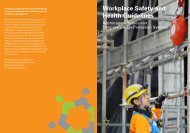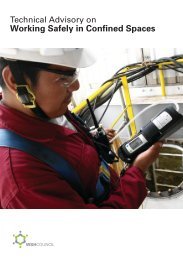Fatigue Management - Workplace Safety and Health Council
Fatigue Management - Workplace Safety and Health Council
Fatigue Management - Workplace Safety and Health Council
You also want an ePaper? Increase the reach of your titles
YUMPU automatically turns print PDFs into web optimized ePapers that Google loves.
Primary Contributing Factors<br />
• Driver B did not fasten his seat belt at the time of the incident. This caused him to be thrown<br />
out of the TPM when the collision occurred. If the seat belt had been properly fastened, he<br />
would not suffer the skull fracture that caused his death.<br />
• Poor mental <strong>and</strong> physical conditions of Driver B due to long hours of work might have caused<br />
a lapse in his concentration, leading to the loss of control of his TPM.<br />
• Driver B did not take the “Compulsory Short Break” m<strong>and</strong>ated by the company’s policy.<br />
Other Contributing Factors<br />
• The lack of a properly designed work schedule for drivers had resulted in Driver B working for<br />
four consecutive night shifts. This might have indirectly caused the driver to be tired <strong>and</strong> to<br />
lose his concentration, which eventually led to the incident.<br />
• Duration of the CSB is deemed inadequate for the drivers to recuperate sufficiently. The<br />
instituted duration of a five-minute break would only provide a break from the driving routine.<br />
As the circadian rhythm in human beings would affect ones ability to perform effectively,<br />
proper rest (including short duration sleep) could greatly improve a person’s ability to work<br />
safely.<br />
Recommendations<br />
• Rules <strong>and</strong> regulation should not be violated. In this case, drivers should attend the<br />
“Compulsory Short Break” to recuperate. They should also utilise the seat belt properly.<br />
• <strong>Management</strong> should have a properly designed work schedule for drivers. 12-hour night shifts<br />
should be limited to two to three consecutive nights, as advised by established guidelines.<br />
• Longer CSB break durations would allow drivers to take short naps to recuperate, thus<br />
improving their performance <strong>and</strong> concentration. Breaks of 20 to 30 minutes (such as “power<br />
naps”) are recommended for drivers of all shifts. Naps longer than 30 minutes will be less<br />
effective as the individual is likely to go into a “deep” sleep pattern. This will cause him to<br />
wake up with a post-nap grogginess. The improvements in alertness <strong>and</strong> performance for<br />
such longer naps would not be optimum. Individuals should also allow sufficient time for<br />
their drowsiness to wear off before resuming work.<br />
• A person should exercise regularly to maintain a good level of physical fitness, so as to avoid<br />
getting tired easily during night shift.<br />
1.4 Legislation<br />
1.4.1 <strong>Workplace</strong> <strong>Safety</strong> <strong>and</strong> <strong>Health</strong> Act<br />
The Act has the intent to inculcate good safety habits <strong>and</strong> practices in all individuals at the<br />
workplace; from top management to the front line worker. It requires every person at the<br />
workplace to take reasonably practicable measures to ensure the safety <strong>and</strong> health of every<br />
workplace <strong>and</strong> worker.<br />
Employers have a duty to provide a reasonably practicable working environment that is safe <strong>and</strong><br />
without risk to the health of employees. This includes removing or controlling the risks of fatigue<br />
by organising <strong>and</strong> planning shift work arrangements, optimising work schedules to minimise<br />
fatigue <strong>and</strong> providing rest breaks.<br />
Employees not only have a duty to take reasonable care for their own health <strong>and</strong> safety but also<br />
for the health <strong>and</strong> safety of others in the workplace.<br />
1.4.1.1 Risk <strong>Management</strong> Regulations<br />
For full details on the WSH Act, please visit MOM website at:<br />
http://www.mom.gov.sg/publish/momportal/en/legislation/Occupational_<strong>Safety</strong>_<strong>and</strong>_<br />
<strong>Health</strong>/workplace_safety_<strong>and</strong>.html<br />
Risk <strong>Management</strong> is a key component to reduce hazards at source. Under the <strong>Workplace</strong> <strong>Safety</strong><br />
<strong>and</strong> <strong>Health</strong> Act, risk management duties are imposed on every employer, self-employed person<br />
<strong>and</strong> principal (including contractor <strong>and</strong> sub-contractor) to take all reasonably practicable<br />
measures to ensure that the workplace is safe for the employees.<br />
Useful guides on Risk <strong>Management</strong>:<br />
• Guide to <strong>Workplace</strong> <strong>Safety</strong> <strong>and</strong> <strong>Health</strong> (Risk <strong>Management</strong>) Regulations.<br />
• Quick Guide to Risk Assessment.<br />
• Risk Assessment Guidelines.<br />
• Activity Based Risk Assessment Form.<br />
• Trade Based Risk Assessment Form.<br />
For more information on risk assessment, refer to the Guidelines on Risk Assessment<br />
available on the MOM website at:<br />
http://www.mom.gov.sg/publish/momportal/en/communities/workplace_safety_<br />
<strong>and</strong>health/maintaining_a_safe_workplace/occupation_safety/risk_management.html<br />
10 11

















